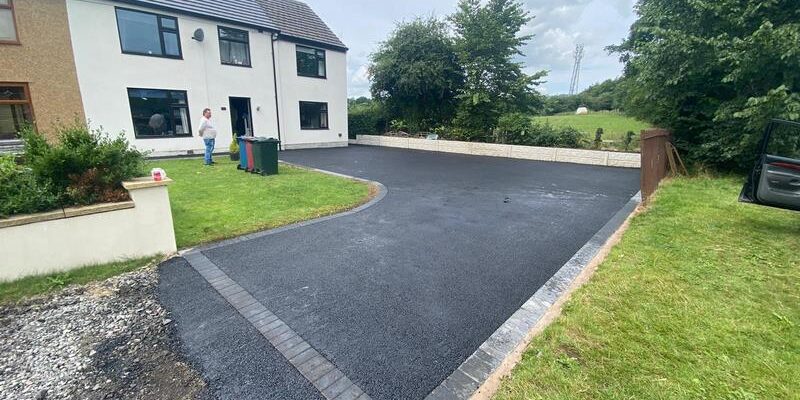We are delighted to take on tenders for larger projects for housing estates and this example proposal gives you an idea at the level of detail we require when you submit a schedule of works for your driveway / tarmac driveways / footpaths.
Can I please have your best price for paving, tarmacadam and associated groundworks all as per the Schedule of Works below this info. Works are to commence soon therefore your prompt response would be appreciated. I believe you work all over Lancashire
We have projects Burnley, Bury and Colne and presume you are happy to work in all 3 areas.
Please let me know if you are not providing a quotation.
Repairs to Footpath and Access Road
SCHEDULE OF WORKS
General
1. Twelve Supported Living Flats in Lancashire
2. All dimensions and quantities stated are approximate and are given only to illustrate the general scope of the work involved. You must visit the site to familiarize yourselves with the location, determine the extent of the works required, make sufficient observations and take the measurements necessary to enable you to prepare your tender.
The Works
3. In brief, the works will comprise the renewal of a footpath and a patch repair to the access road.
Health and Safety
4. The Contractor shall adopt safe methods of work and comply with all other requirements of the Health and Safety at Work etc Act 1974 and the COM Regulations 2015 in order to protect the health and safety of its personnel, residents, visitors to the scheme and all other persons.
5. The Contractor will be required to undertake a risk assessment and develop method statements for all significant risks identified. The method statements shall include information on the major items of plant and construction methods to be used. The method statements are to be approved by the Contract Administrator
prior to the works commencing.
6. There are no facilities at the site for offices, sanitary and welfare facilities, storage, power, water or telecommunications. The Contractor shall forward information to the Contract Administrator at least one week prior to the works commencing, detailing his proposals and shall include here any costs for provision of any temporary facilities as may be required.
Supervision
7. The Contractor is to ensure that a suitably qualified and experienced foreman (or equivalent) is on site during all working hours to direct work activities including plant and personnel. The foreman shall ensure that the works are carried out safely and efficiently.
Security
8. Security at the site is entirely the Contractor’s responsibility. The Contractor is to provide and maintain suitable security measures throughout the period of the works.
9. When parked overnight or at weekends, all plant is to be covered and/or protected in an appropriate manner to ensure any possible vandalism is kept to a minimum (e.g. all fuel filler points must be secured, windscreens must be shielded etc).
10. To allow access for emergency vehicles, wherever possible, plant should not be parked overnight or at weekend on the access road.
Damage and Reinstatement
11. The Contractor shall take all necessary precautions to avoid damaging all land and property, including highways, adjacent areas within the car park and access ways, buildings, boundary walls, fences, structures, grassed areas, plants etc.
12. On or before completion he shall make good any damage caused, including by sub-contractors and suppliers, and clean away any debris at his own expense, to the satisfaction of the Contract Administrator.
13. Making good shall be with identical and matching materials or the complete item(s) shall be replaced with approved alternative materials.
Plant and Equipment
14. The Contractor is to supply all necessary plant and equipment to ensure the safe and efficient completion of the works and is to allow for all necessary associated work including fuelling, maintenance and cleaning.
15. Copies of all personnel certification/machine tickets must be provided by the Contractor prior to the works commencing.
16. Copies of all risk assessments and method statements must be provided by the Contractor prior to the works commencing.
17. The Contractor shall choose appropriate plant and use best practice to minimise the amount of noise and vibration during working hours.
Access
18. The only means of vehicular access to and from the site is off the access Lane. This access will need to remain open for the duration of the works. The contractor will need to make provision for a safe and segregated pedestrian and wheelchair access for residents, staff and visitors.
19. On no account shall the Contractor prevent or obstruct access to any property, unless unavoidable for safety or other reasons and only with the permission of the Contract Administrator.
20. The contractor will need to implement any physical barriers to the access road and footpath to exclude vehicles and pedestrians from the work area, using suitable traffic management equipment, maintain them for the duration of the works and remove them upon the re-opening the access road and footpath after completion of the works.
Car Park Patching Repair
21. Cut the boundaries of the patch square using either a diamond saw or pneumatic hammer with a spade bit and break out to a depth of 1OOmm. Approximate area 3.19m2 – see attached sketch.
22. Remove water and debris from the hole. Square up the sides of the hole until the edges of the hole are sound. Apply a tack coat of asphalt emulsion to the sides and bottom of the hole at a rate of approximately 1 litre / m2 (0.2 gal/yd2) of slow or rapid setting emulsion.
23. Supply and lay tarmacadam comprising of 40mm dense bitmac (6mm aggregate) wearing course; laid on 60mm dense bitmac (20mm aggregate) base-course. The hole should be overfilled by 20 to 25 percent of its depth to provide adequate material for compaction.
24. Compact the patch material with a hand device or a small vibratory roller. The finished patch should have a 3 to 6 mm crown.
25. The patched area should be seamed with crack sealant and fog sealed.
Footpath
26. Break out and remove existing concrete footpath as shown on sketch to a depth of 255mm. Kerb line length is about 20m and the average width of 1.7m so the approximate area is 34m2 .
27. Break out and remove concrete kerb edging, foundations and flaunching (highlighted pink on the attached sketch). Supply and lay new 915 x 305 x 1OOmm half-battered concrete kerbs laid on 100mm well compacted 1:2:4 (cement: sand: aggregate) semi dry concrete with 150mm flaunching. Kerbs to be laid close jointed (around 2 to 4mm joints), not butt joints. Allow for making good to tarmacadam adjacent to new kerb edging.
Allow a length of 20m @ £x p/m
28. Break out and remove precast flat top kerb edgings, foundations and flaunching (highlighted green on the attached sketch). Supply and lay new 915 x 200 x 50mm precast flat top kerb laid on 1OOmm well compacted 1:2:4 (cement : sand : aggregate) semi-dry concrete with 150mm flaunching. Kerbs to be laid close jointed (around 2 to 4mm joints), not butt joints.
Allow a length of 18m @ £x p/m
29. Prepare base and supply and lay 150mm sub base consisting of Type 1 Granular Material to SHW Clause 803 and prepared and installed to SHW Clause 802. Supply and lay 75mm road base consisting of cement bound granular material C8/10 to SHW Clause 821 and prepared and installed to SHW Clause 813 and 814. Supply laying course consisting of proprietary modified mortar in line with BS7533 Part 4 2006. See Marshall Drawing
30. Supply and lay 600 x 600mm Marshalls Saxon Buff fibre reinforced paving slabs with 8 to 1Omm joint widths.
31. Adjust all iron works (manhole chambers, water/gas stop tap boxes etc) to required levels. The iron works should be adjusted in height to the required finish surface level suiting the relevant falls and cross falls to assist water escape. Allow for adjusting the height by means of heightening /lowering where required on sand and cement mix with suitable spacing materials/ packing pieces as required.






